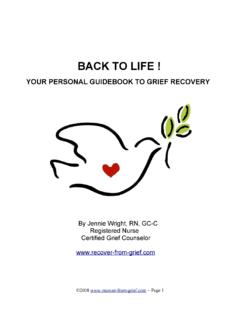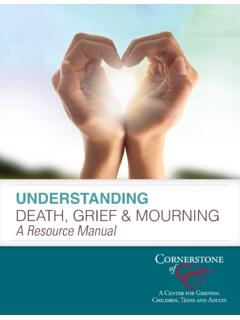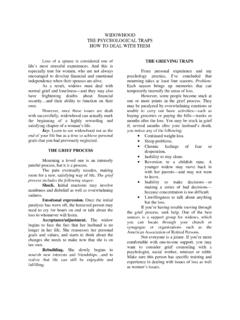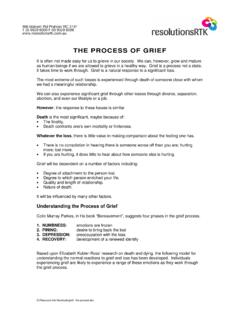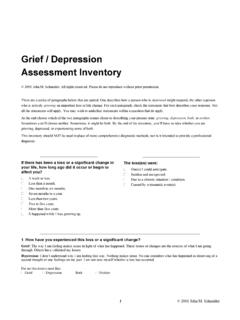Transcription of On the Wings of Grief - Simpler Times
1 On the Wings of GriefA Bereavement Journal for AdultsKnott, Gene, Responding to Grief : Themed Group for Bereavement Support , The Clearinghouse for Structured/Thematic Groups & Innovative Programs, University of Texas at Austin, 2007. < >National Funeral Directors Association, Create a Journal to Help Ease Grief , November, 2002. < >My Healing Place, What an Adult Needs During Grief , 2012. < >Lundquist, K, and Nelson, V, Personal Reflections on Death, Grief and Diversity , in Ethnic Variations in Dying, Death, and Grief : Diversity in Universality, Taylor & Francis, Sources All literary quotations can be found on the Goodreads website at Times On the Wings of Grief3 Table of ContentsINTRODUCTION ..5 Where are You in this Journey? ..7 The Four Tasks of Mourning ..9 How Do You Feel about Grieving? ..11 Grief Work and Growing Stronger ..13 JOURNAL WRITING ..14 For Breathe ..15 Writing the Story: Getting Comfortable with Heartache ..16 Developing Self-Awareness: What s Going on in My Head?
2 ! ..18 Capture a Shared Special Moment ..19 When I Think About You, I ..21If I Could Talk to You Again, I d Tell ..22 One of My Fondest Memories of You ..23 One of My Least Favorite Memories of You ..24 Capturing Dialog: Chronicle Your Wishes and Regrets ..25 Write a Letter to Your Loved One ..26 Looking to the Future ..29 YOUR Grief , CONTAINED ..30On the Wings of Grief Simpler Times4 Simpler Times On the Wings of Grief5 IntroductionThank you so much for practicing self-care in your bereavement. By requesting a copy of this journal, you ve taken a big step in adjusting to the death of your loved one. While it is intended to be the companion to the year-long series of daily email messages with the same name, On the Wings of Grief , it can also be used on its own to help along the path of your bereavement journey. Visit our website to sign up for these daily messages of choosing to download this journal, you ve revealed something very important. You believe that by taking certain steps, you can recover your emotional, physical and spiritual equilibrium after the loss of your loved one.
3 You believe, deep down, that you can put the death of your loved one into perspective and discover your inner resolve to continue living without them. Consider this question and write your response in the space below: Exactly what do you want to bring into your life from working in this journal?On the Wings of Grief Simpler Times6 Many people respond to that question by saying, I just want to feel better and that s enough. If you can identify the ways you want to feel better physically, emotionally, or spiritually, it can help you along the bereavement journey. The stresses of grieving are hard to bear and learning new ways to take good care of yourself can lessen their effects. Working to realign your spirituality after the death of a loved one; learning to enjoy the simple pleasures of eating, sleeping, and spending time alone or with friends; and tending to the care of your body are all valid desires. So, do your best to be as specific as you can in your answer to that question.
4 Grief is a most peculiar thing; we re so helpless in the face of it. It s like a window that will simply open of its own accord. The room grows cold, and we can do nothing but shiver. But it opens a little less each time, and a little less; and one day we wonder what has become of it. Arthur Golden, Memoirs of a GeishaSimpler Times On the Wings of Grief7 Where are You in this Journey? Human beings have a need to categorize their collective experiences. In the study of Grief and bereavement, there have been theories involving the description of stages, tasks, and phases but when you re in the midst of grieving a major loss, does it really help you to know any of them? Perhaps it does to the degree that you can better understand where you are in your journey of acceptance and adjustment. It s also valuable to know that some of the theories don t actually apply to your bereavement experience. Elizabeth Kubler-Ross proposed a well-known model of Grief which includes these 5 stages: denial, isolation, anger, bargaining, depression and acceptance?
5 She intended them to describe the adjustment process undergone by terminally ill patients in relation to their own death. This means that these 5 stages are not important to us here. However, you should recognize which phase of grieving you are in as identified by Dr. Gene Scott in the group Grief counseling guide Responding to Grief : Theme Group for Bereavement Support . On the Wings of Grief Simpler Times8 Phase 1 This describes the early days after loss, which involve developing a deepening awareness that your loved one has truly died. It only lasts a few hours or couple of days. Characterized by a bittersweet mixture of feelings and activities, this phase may bring a sense of numbness or relief with the need to notify friends and other family members of the death and attend to funeral arrangements. For some, the need for solitude is overwhelming in this early phase. Phase 2A lengthy intermediate period usually lasts between several months and a couple of years and is the time where we adapt to the situation of not having our loved one in our day-to-day life.
6 It s a period of transition from the early days of coping with the immediate issues of arranging the funeral and dealing with legalities to the assumption of some of the roles played by our now-deceased loved one. Dr. Scott describes these roles as perhaps mundane tasks like housekeeping or bill-paying but they may also involve tending to the emotional or physical needs of other family members. Phase 3Dr. Scott refers to this phase as a period of accommodation, which lasts until our own death. He cautions us that this should not be considered a time of closure, resolution, or healing; it s more like finding a way to integrate the loss into our on-going daily life. It is, he so beautifully describes, how we spend the rest of our lives with the memories of our loved ones, celebrating our shared positive moments, while accepting the less-warm pieces of our co-history with them. There s Grief work to be done related to each of these three phases and this journal is designed to support you wherever you are in your bereavement journey.
7 Yet, for the sake of personal clarity, in which phase do you believe yourself to be? Phase 1: My loved one died recently. I still feel overwhelmed by the loss. Phase 2: It has been less than eighteen months since the death of my loved one. Phase 3: I am no longer grieving intensely or for long periods of time. Simpler Times On the Wings of Grief9 The Four Tasks of MourningIt was Sigmund Freud who first brought up the concept of Grief work and although the specific tasks he outlined have been reconsidered in the years since the publication of his book Mourning and Melancholia in 1917, the idea that bereavement is purpose-driven continues into the 21st century. Years later, professor of psychology, James Worden chose to see the work of bereavement as task-oriented. In the 1996 article Tasks and Mediators of Mourning: A Guideline for the Mental Health Practitioner , he outlined the following four tasks: 1. To accept the reality of the loss2. To process the pain of grief3. To adjust to a world without the deceased4.
8 To find an enduring connection with the deceased in the midst of embarking on a new lifeThe work you have undertaken will focus your attention on achieving each of those goals. It will not occur in any logical order since after all, each of us is different and the path we walk in the bereavement journey is not a straight one. In fact, those of us in mourning naturally fluctuate between sadness and normalcy. It is a process of adaptation, where we juggle our attention between loss-oriented activities (processing the pain of Grief ) and restoration-oriented activities (adjusting to life without our loved ones by striving to create enduring connections with the deceased.) While not referring to the labors of bereavement, the famous French writer, Honor de Balzac captured the value of Grief work when he said, All happiness depends on courage and work. It really does take both courage and hard work to successfully adapt to the loss of a significant person in your life. I have returned from a world beyond knowledge And now must unlearn for otherwise I clearly see I can no longer live.
9 Charlotte Delbo, Auschwitz and AfterOn the Wings of Grief Simpler Times10 Simpler Times On the Wings of Grief11 How Do You Feel about Grieving?Before we go any further, it s time to examine and change the way you might think of Grief and bereavement so you can free your mind for the work ahead. Let s take a moment to complete a short quiz to see what you believe to be true about grieving the loss of a loved Following the death of a close family member, how long would you expect the survivors to grieve? 0-3 months 3-6 months 6-12 months 1-2 years 2+ years2. How long would society expect them to grieve? 0-3 months 3-6 months 6-12 months 1-2 years 2+ years3. Would you express intense personal feelings of Grief publicly? No Yes Depends4. How long after a death would you begin to worry that someone is grieving abnormally? 8 weeks 3-6 months 6-12 months 1-2 years 2+ years5. Which survivor do you feel is at greatest emotional risk during Grief ? Older male Older female Young male Young female Young child Older child6.
10 After what period of time would you consider it acceptable for a surviving adult :Return to work:Date:Stop grieving:7. What is the first task a survivor must complete in order to heal? Accept reality Detach from the past Keep busy Experience the pain Set new goals Don t knowOn the Wings of Grief Simpler Times12 The myths and misinformation about Grief can create a great deal of harm and prevent others from helping you through the grieving process. Read through this list of the most common myths and ask yourself if you believe any of these examples of mistaken thinking to be true. Put a check mark by those you feel are a part of your current thinking and then let go of them for good: Myth #1: The goal of Grief is to get over it. This is simply not true; the goal of Grief is to find an enduring connection with the deceased in the midst of embarking on a new life. (Worden, Grief Counseling and Grief Therapy, 2009) Myth #2: If you ignore Grief it will go away. Unfortunately, choosing to ignore something this big is only bound to fail.


